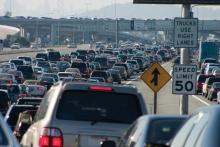In the UK, the necessary radio spectrum has been identified and standardised technology developed to allow cost effective wireless communication between cars, devices and other ‘machines’. This by Professor William Webb. A world free of traffic congestion, with intelligent systems directing vehicles and alerting drivers to free parking spaces may sound a far off fantasy to motorists stuck in seemingly endless queues on the outskirts of London. Yet this is a scenario not confined to the world of science fict

Professor William Webb is one of a number of IEEE professionals to have joined forces to develop standardised technology to work with the ‘white space’ spectrum for low cost wireless communication between machines
In the UK, the necessary radio spectrum has been identified and standardised technology developed to allow cost effective wireless communication between cars, devices and other ‘machines’. This by Professor William Webb.
A world free of traffic congestion, with intelligent systems directing vehicles and alerting drivers to free parking spaces may sound a far off fantasy to motorists stuck in seemingly endless queues on the outskirts of London. Yet this is a scenario not confined to the world of science fiction. Monitoring traffic flow is relatively easy, as is deducing where congestion is occurring and working out where to reroute cars. However, there is still a big piece missing from the intelligent transport puzzle – in the UK at least – a way to get information from sensors to controls centres, and from there back to cars, traffic lights and roadside signage.Faced with this challenge, wireless connectivity is the only option. This is obvious in the case of moving vehicles, but even for sensors such as those on bridges or embedded into parking spaces, the cost of running wires into each one would be prohibitive.
In the modern world of the iPhone and mobile broadband, it is understandably easy to imagine that this problem of connectivity would be solved. This is not the case. Not only would it be extremely expensive to install a mobile broadband connection into each parking space (both in terms of the electronics needed and the cellular subscription to be paid), but it would lead to overloading of the already stretched available network bandwidth to such a level that there would be no capacity left for anything else, for people to access Facebook or any other social media.
Furthermore, such sensors need to run from batteries for many years and as all cellphone users know, battery life of even a few days is a challenge for mobile broadband devices.
Catering for machines
Although mobile networks are great for people, they are terrible for machines. The needs and applications are so very different that there is little use in trying to use one network for both. In fact, a principal contributory cause of traffic congestion is the lack of wireless networks designed for sensors, traffic lights, or ‘machines’ in general.A network designed for machines would be similar in many ways to a mobile network – it would consist of base stations located across the country to provide coverage everywhere, ideally better than today’s cellular networks. Wireless chips, embedded in machines, would ‘talk’ to these base stations. Messages would be routed across networks to control centres.
However, the wireless technology itself would be quite different. Firstly, it would deliberately use much lower data rates than mobile broadband to allow greater range, as well as simpler and more cost effective chip sets and longer battery life. It would require only low-power transmitters to keep the cost of a chip set to about £1.
It would allow for messages to be broadcast to groups of machines, such as all traffic lights in a city. In addition to this, it would be optimised to cope with large numbers of short messages being sent intermittently, rather than rapid connection and multimedia download. It would allow machines to ‘sleep’ for much of the time, allowing them to conserve their batteries for up to 10 years.
A wireless network like the one outlined above would allow wireless connectivity to be embedded everywhere. It would not apply just to cars, parking spaces and traffic lights, but also to gas meters, heart rate monitors, microwaves and dog collars, among many other things.
Looking for spectrum
The key reasons for such a network not emerging to date can be boiled down to two – a lack of vision and a lack of radio spectrum. The latter is a seldom mentioned necessity for all wireless communications, though occasionally makes headlines. Most recently, in the run up to the London Olympics, the UK’s communications regulator Ofcom has had to strive to ensure sufficient mobile spectrum is available to satisfy massive surges in wireless traffic, which is predicted to grow by more than double during the Games.Spectrum comes in a number of different frequencies and bandwidths, and a machine system would require spectrum with very particular characteristics. It would need spectrum where radio signals travel far and where there is enough capacity for perhaps one billion devices in the UK alone. Crucially, the spectrum would have to be much less expensive than the £22bn paid by 3G operators in the UK, because car park sensors will not pay as much per month as iPhone users.
Only recently has spectrum fitting these characteristics been found, and work is still under way in the UK to make it available for commercial use. A number of engineers of companies and institutions such as the
This technology has been termed ‘Weightless’. The cost of Weightless chips is expected to fall rapidly to around £1 each and it is hoped that they will become embedded everywhere and for nationwide and indeed global networks to be deployed from 2013 onwards. Such networks would most likely be general purpose, installed by national operators with equivalent role and reach as current mobile operations. They would serve many different applications such as transport, smart grids, smart cities, asset tracking and much more, enabling expenditure to be spread wide and cost per terminal kept very low.
Manufacturers of devices from cars to cat collars could then opt to deploy Weightless chips within their products. Vehicle
manufacturers might embed the chips within engine management and vehicle guidance systems. Transportation authorities might fix them to traffic lights, street lighting and other urban infrastructure to reduce the cost of maintenance. These chips will communicate behind the scenes with networks, databases and control centres, making things work better – traffic will flow, meters will be read automatically and washing machines will be able to communicate with owners’ smartphones to send warning if an outlet pipe is becoming blocked.
Many interested parties from chip companies to smart meter manufacturers and government departments are currently working within the Weightless standards body to ensure that the features they require are included and the technology is proven through trials. The technology is on the way and this future is just around the corner.














